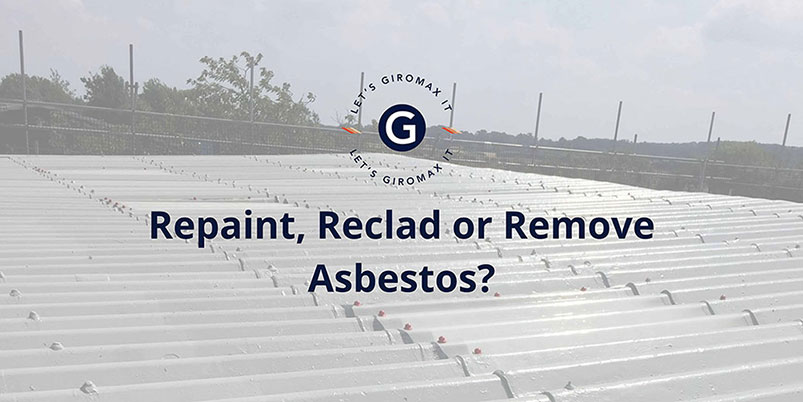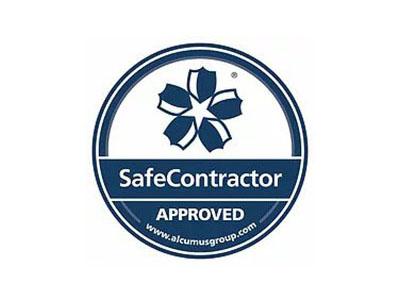Repaint, Reclad or Remove Asbestos?
Certain types of asbestos have long been recognised for causing considerable damage to people’s health once exposed. Building owners need to take full responsibility for dealing with asbestos on their premises, as they’re likely to be held accountable for any harmful effects. But is it better to remove, clad, or paint over asbestos to seal in dangerous fibres?
The main problem with asbestos exposure is when this material is disturbed, due to damage or wear and tear. Before this happens, asbestos issues need to be addressed as quickly as possible. Although its use was banned from UK construction over 20 years ago, it is still present in many industrial buildings. It’s possible that some of your clients may not even be aware they are located within buildings containing asbestos, especially if they are tenants.
Health issues caused by asbestos
Known to be a major health issue once fibres are released into the air, the effects of exposure to asbestos fibres are cumulative over time, as they can’t be removed from the lungs. It can take years before asbestos damage starts to result in long-term health problems. Common health conditions caused by asbestos exposure include asbestosis, mesothelioma, various cancers, and benign pleural conditions.
Removing asbestos
When it comes to external roof and cladding, over time, excessive exposure to the elements can create damage and cracks. This creates ongoing and potentially costly maintenance issues. Any disturbance to a sheet of asbestos could generate problems, with strict disposal regulations pushing up removal costs.
On the exterior of a building, asbestos can be commonly found in:
- Asbestos cement roof, gutters or downpipes
- Asbestos cement panels or soffits
- Asbestos cement flue
Removing asbestos is a particular area of concern, with a need for strict protocols to limit exposure. It can be extremely expensive, as it requires the relocation of employees from within the building while the work is carried out. If the building is a factory, the long-term financial impact of temporarily closing operations while the problem is being addressed can have a massive impact on revenue.
Recladding asbestos
Installing cladding over the top of asbestos could seal this in, making it impossible to be exposed to any damaging fibres. But there are major issues with this approach; the weight of extra cladding on top of the asbestos layer has the potential to compromise the structural integrity of the building. Consideration also needs to be given to snow load, which could cause structural failure to the roofing system. Moreover, planning permission is required for over-cladding, whereas painting doesn’t involve any planning approvals.
Repainting asbestos
Repainting exterior building materials containing asbestos is the most convenient and cost-effective solution by far, using a coating product specifically designed for this purpose. There’s no need to relocate to new premises while work is being undertaken, and there’s none of the disruption, safety issues and costs associated with removal or recladding.
Repainting with an asbestos coating product
Repainting ensures a safe and long-lasting solution to protect against asbestos in a commercial building. Dangerous asbestos fibres are sealed in, so your client’s roof will be protected for years to come. It’s possible to extend the life of an asbestos roof for a further 20 years, making this a cost-effective solution to the problem.
Start with a base coat primer
Our Giromax® Roofcoat system is moisture tolerant, sticking to the asbestos and sealing in the dangerous fibres while still wet, which makes it extremely popular with health and safety inspectors. This product gives the topcoat a uniform finish to adhere to, locking in any loose asbestos fibres and sealing in porosity.
The Giromax® Roofcoat also ensures a more pleasing overall appearance. Without the use of a primer-based coating system, the asbestos roof coating won’t give the required finish, so this is an important part of the process. There is a risk that the coating would dry with a patchy appearance, with some areas having a matt finish, while other parts appearing glossy.
When it comes to asbestos, some of your clients may need advice on how to deal with this dangerous material. Our innovative and cost-effective Giromax® Roofcoat can be safely applied to roofing systems containing asbestos, instead of costly or dangerous removal. Protect your roof for up to 20 years with our breathable, moisture tolerant, flexible coating.
Our technical expertise includes application guidance. Please speak to the Giromax team or call 01455 558969 today.
Get updates from us
Sign up to our newsletter to receive all the latest news and insights from Giromax Technology.
Subscribe to NewsletterRelated articles
5 Reasons why Dilapidation Surveys are Important
Dilapidation surveys protecting your roof investment, ensuring compliance and safety standards, and accurate repair and maintenance planning.
5 Common Cladding Issues and How to Fix Them
Common cladding issues include cracking and structural damage, water ingress and moisture-related problems. We explore ways to fix cladding.
5 Commercial Roofing Industry Trends & Innovations in 2025
The latest commercial roofing industry trends include smart roofing technology, IoT, sustainable roofing solutions and advanced roof coatings…









